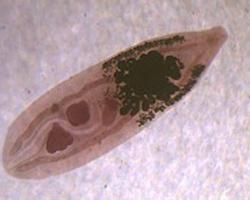
State of endangerment
| Non Endangered |
Animal description
The Canadian liver fluke, scientifically named Metorchis conjunctus, is a parasitic flatworm belonging to the class Trematoda. This parasite primarily infects the livers of various mammals, including humans, dogs, cats, and particularly fish-eating mammals like bears and foxes. It is endemic to North America, especially prevalent in Canada, hence its common name. The lifecycle of Metorchis conjunctus is complex, involving multiple hosts and environmental conditions to facilitate its development and spread.Morphologically, the Canadian liver fluke is small and leaf-shaped, with a body that can range from 2 to 5 millimeters in length. It has a distinctive oral sucker located at its anterior end and a ventral sucker, which it uses to attach to the bile ducts of its host’s liver. The body of the fluke is covered in a tegument, a specialized type of epithelium, which helps in protection and absorption. Internally, Metorchis conjunctus possesses a simple digestive system starting from the mouth, leading into a pharynx, and then branching into two blind-ending caeca. Reproductively, these flukes are hermaphroditic, containing both male and female reproductive organs, enabling them to produce eggs within the host's liver.
The lifecycle of Metorchis conjunctus involves three hosts: a definitive host where the adult flukes reside and reproduce, and two intermediate hosts that facilitate its development. The first intermediate host is typically a freshwater snail, in which the released eggs from the definitive host hatch into miracidia, which then infect the snail. Inside the snail, the parasites develop into sporocysts, rediae, and then cercariae, the latter of which emerge from the snail into the water. The cercariae then seek out the second intermediate host, usually a freshwater fish, and encyst as metacercariae in the fish's tissues. When a definitive host consumes infected fish, the metacercariae excyst in the small intestine, migrate to the bile ducts of the liver, and mature into adult flukes, thus completing their lifecycle.
Infection with Metorchis conjunctus, known as metorchiasis, can lead to a range of symptoms in definitive hosts, from asymptomatic to severe liver damage, depending on the intensity of the infection. Symptoms may include jaundice, abdominal pain, fever, and in severe cases, liver fibrosis or cholangiocarcinoma. Diagnosis typically involves the detection of eggs in the stool, and treatment can include antiparasitic medications.
The presence of Metorchis conjunctus in wildlife and domestic animals highlights the importance of monitoring fish and water quality, as well as promoting awareness of the risks associated with consuming raw or undercooked freshwater fish. Conservation efforts and veterinary interventions play crucial roles in managing the populations of this parasite and preventing its transmission to humans and other animals.
Similar Animals
New photos of animals
Top 10 animals
- Dolphin gull (Leucophaeus scoresbii)
- Diana monkey (Cercopithecus diana)
- Moustached guenon (Cercopithecus cephus)
- Galápagos tortoise (Geochelone nigra complex)
- Japanese macaque (Macaca fuscata)
- Stone loach (Barbatula barbatula)
- Russian tortoise (Testudo horsfieldii)
- Greek tortoise (Testudo graeca)
- Common flying dragon (Draco volans)
- Vendace (Coregonus albula)


